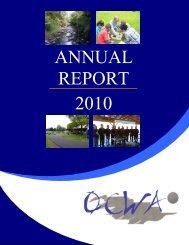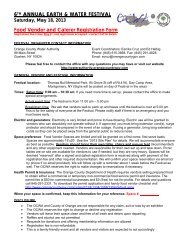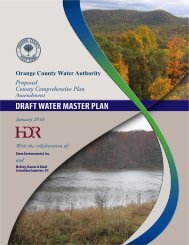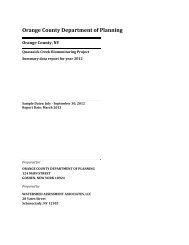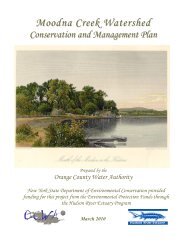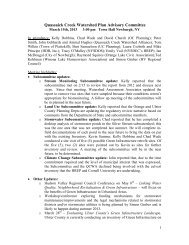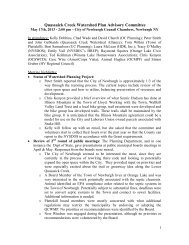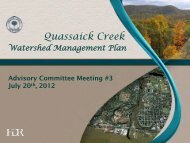Biodiversity of the Moodna Creek Watershed - Orange County Water ...
Biodiversity of the Moodna Creek Watershed - Orange County Water ...
Biodiversity of the Moodna Creek Watershed - Orange County Water ...
You also want an ePaper? Increase the reach of your titles
YUMPU automatically turns print PDFs into web optimized ePapers that Google loves.
Appendix A. Flagship Species <strong>of</strong> <strong>the</strong> <strong>Moodna</strong> <strong>Creek</strong> <strong><strong>Water</strong>shed</strong><br />
The following wildlife species represent <strong>the</strong> diversity <strong>of</strong> habitats in <strong>the</strong> <strong>Moodna</strong> <strong>Creek</strong> watershed. In many cases, conservation <strong>of</strong> <strong>the</strong>se species will<br />
contribute to conservation <strong>of</strong> o<strong>the</strong>r plants and animals with similar habitat needs. Information on recommended habitat and buffer sizes, important<br />
temporal considerations, and additional conservation concerns are included. (Note that many <strong>of</strong> <strong>the</strong>se species use a complex <strong>of</strong> different habitats, in<br />
addition to <strong>the</strong> priority habitat group listed here.)<br />
Common Name<br />
Priority Habitat<br />
Group<br />
Habitat Needs<br />
Conservation Considerations<br />
American woodcock<br />
Scolopax minor<br />
Grassland,<br />
Shrubland, and<br />
Farmland<br />
While woodcocks are considered a resident <strong>of</strong> Woodcock decline is attributed to loss <strong>of</strong> early-successional<br />
forests, where <strong>the</strong>y forage for earthworms and habitat from changes in forest structure, fire suppression, and<br />
nest in young, early-successional woodlands, shifts in agricultural practices. Management may be necessary<br />
<strong>the</strong>y also require open field habitats. Nighttime to maintain <strong>the</strong> habitat complex needed for woodcock:<br />
roosting occurs in nearby old fields, at least 1 shrublands or young forests with moist productive soils, second<br />
ac (0.4 ha) in size, and woodcocks engage in growth hardwoods for nesting, and openings or fields for<br />
courtship in shrublands and old fields in early singing grounds and night roosting. Nesting and fledgling<br />
spring.<br />
activity occurs from March through August.<br />
Bobolink<br />
Dolichonyx oryzivorus<br />
Grassland,<br />
Shrubland, and<br />
Farmland<br />
Grassland birds, including <strong>the</strong> bobolink, are threatened by<br />
habitat loss due to development, changes in agricultural<br />
practices, and <strong>the</strong> return <strong>of</strong> grassland to forest. While bobolink<br />
Breeds in open grasslands and hay fields. has one <strong>of</strong> <strong>the</strong> smallest area requirements for successful<br />
Bobolink will breed in grasslands <strong>of</strong> 10-75 breeding, o<strong>the</strong>r grassland species need larger areas and have<br />
acres (4-30 ha), but larger areas are better and varying requirements for open patches, density <strong>of</strong> vegetation,<br />
are more likely to support o<strong>the</strong>r specis <strong>of</strong> etc. Where possible, restoration or conservation <strong>of</strong> grasslands<br />
grassland birds that have greater habitat <strong>of</strong> at least 100 acres (40 ha) is encouraged, with management<br />
requirements.<br />
appropriate to <strong>the</strong> breeding species present on <strong>the</strong> site.<br />
Grassland birds are ground-nesters; mowing activity should be<br />
restricted during <strong>the</strong> breeding season. Bobolink nesting and<br />
fledgling activity occurs from May through July.<br />
Timber rattlesnake<br />
Crotalus horridus<br />
Cliffs and Caves<br />
Mountainous or hilly deciduous or mixed<br />
forests, <strong>of</strong>ten with rocky outcroppings, steep<br />
ledges, and rock slides. Dens, or hibernacula,<br />
are <strong>of</strong>ten located on south-facing slopes, in<br />
talus or rock fractures that provide retreats for<br />
overwintering. Rattlesnakes use open canopy,<br />
rocky areas for basking, shedding, gestating,<br />
and birthing. Foraging areas are generally<br />
located within forested habitat surrounding <strong>the</strong><br />
den, but may also include old fields and<br />
wetlands.<br />
Timber rattlesnakes emerge from winter dens in April or early<br />
May, and return to den areas in mid-September, with most<br />
snakes in <strong>the</strong> hibernacula by late October. During <strong>the</strong>ir active<br />
months, rattlesnakes can travel great distances and use large<br />
areas <strong>of</strong> habitat, traveling 3300-7900 ft (1000-2400 m) to<br />
forage, bask, breed, nest, and hibernate. Illegal collection and<br />
and unnecessary killing are serious threats to <strong>the</strong> species.<br />
Increasing habitat fragmentation from development is also a<br />
concern, and may increase <strong>the</strong> likelihood <strong>of</strong> human-snake<br />
interactions.



